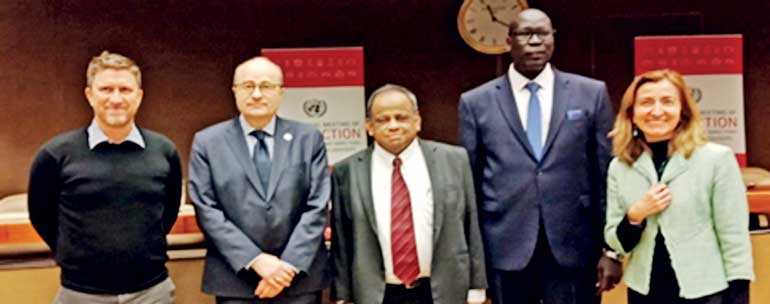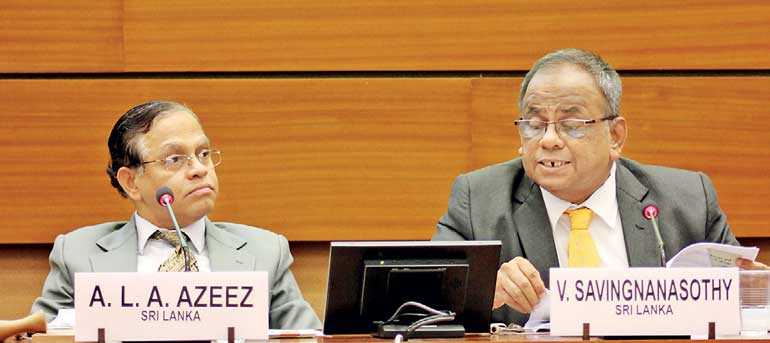Tuesday Apr 08, 2025
Tuesday Apr 08, 2025
Tuesday, 26 February 2019 00:54 - - {{hitsCtrl.values.hits}}


The 30-year-long civil conflict in Sri Lanka left many areas of the Northern and Eastern part of the country contaminated by anti-personnel mines and Explosive Remnants of War (ERW). The International Meeting on Mine Action for National Directors and UN Advisors was held from 5 to 8 February in Geneva at the UN office. This meeting was aimed at discussing the lesson learnt, best practices and emerging issues of the mine-affected countries.
It is noted that the Suspected Hazardous Area was initially 1302 km2 mostly in the eight districts of the Northern and Eastern Provinces. The mines clearance program enabled the release of a large area of 1277 km2 for safe settlement, and as a result directly and indirectly contributed to the resettlement of 258,000 families, said Ministry of National Policies, Economic Affairs, Resettlement and Rehabilitation Secretary and Vocational Training and Skills Development, Permanent Resident Representative V. Sivagnanasothy.
As at end of 2018, only 25 km2 remains to be cleared. This area includes Muhamalai in Kilinochchi District, Nagarkovil in Jaffna District, Maritimepattu and Oddusudan in the Mullaitivu District and other areas in the Northern and Eastern Districts. Out of the eight districts, Batticaloa has been declared a mine-cleared area. Under the district-by-district approach, Trincomalee and Jaffna are proposed to be cleared in 2019. The Government’s vision is to make Sri Lanka a mine-free country by 2020. This requires additional estimated funds of $20 million. Currently the HALO Trust, MAG, the Sri Lanka Army, DASH and SHARP are involved in the demining work. This achievement of Sri Lanka in comparison to other countries was commended at the International Meeting on Mine Action for National Directors and UN Advisors.
The collaboration of national ownership, Government commitment, the availability of the national mine action strategy, Government resource mobilisation, a robust monitoring and evaluation framework, the dedicated institutional structure of the National Mine Action Centre within the Resettlement, Rehabilitation and Northern Province Development Division of the Ministry, and the Information Management System with disaggregated data that have all been used to work towards this goal has been commended at the meeting, said Sivagnanasothy.
The Sri Lankan delegation comprised Sivagnanasothy, UN Geneva Ambassador A.L.A. Azees and Vocational Training and Skills Development Deputy Permanent Representative Samantha Jayasuriya. The plenary session was chaired by Permanent Representative of Norway, Geneva Ambassador Hans Battskar, with the participation of Child Protection Area of Responsibility Global Coordinator Michael Copland and UNICEF Germany Chief of Child Protection Julie Gill. A side event was also organised to share best practices. The HALO Trust and MAG participated in the technical session.
The Sri Lankan Mine Action Program includes land mine and ERW clearance, stockpile destruction, mine risk education, and a victim assistance program covering the humanitarian perspective as well as the development perspective, which was considered a holistic approach. Moreover, the Mine Risk Education Program with the support of UNICEF and other stakeholders integrated mine risk education at schools, communities and media. It also paid special focus to high-risk groups such as scrap metal collectors, firewood collectors, garbage burners and re-settlers who burn bushes for land clearing. Mine risk education was successfully implemented and promoted risk reduction behaviour. As a result, the casualties both deaths and injuries of the mine victims, which was 211 in 2001, was reduced to zero in 2018. The statistical evidences shows increased reporting by civilians on explosive devices, and reduction in the lead time for disposal of mines and explosive devices, said Sivagnanasothy.
Furthermore, mine risk reduction strategies such as “safe play areas” for children, mapping and marking, sign boards and fencing of risk areas helped reduce mine victims. Victim-assistance programs included the provision of first aid, medical care, rehabilitation by providing artificial limbs (prosthetics) and other assistive devices such as wheelchairs, crutches, walking sticks etc. The program also included addressing trauma through psycho-social support vocational training and skills development, catch-up education and social and economic programs, which were also initiated and expanded. The Ministry of National Policies, Resettlement and Rehabilitation and Northern Province Development, with the Ministry of Social Services and Ministry Of Health are making efforts to strengthen the victim-assistance program. The International Meeting on National Mine Action for National Directors highlighted Sri Lanka as a possible model country for promoting the Mine Action Program, said Sivagnanasothy.
Discover Kapruka, the leading online shopping platform in Sri Lanka, where you can conveniently send Gifts and Flowers to your loved ones for any event including Valentine ’s Day. Explore a wide range of popular Shopping Categories on Kapruka, including Toys, Groceries, Electronics, Birthday Cakes, Fruits, Chocolates, Flower Bouquets, Clothing, Watches, Lingerie, Gift Sets and Jewellery. Also if you’re interested in selling with Kapruka, Partner Central by Kapruka is the best solution to start with. Moreover, through Kapruka Global Shop, you can also enjoy the convenience of purchasing products from renowned platforms like Amazon and eBay and have them delivered to Sri Lanka.
Discover Kapruka, the leading online shopping platform in Sri Lanka, where you can conveniently send Gifts and Flowers to your loved ones for any event including Valentine ’s Day. Explore a wide range of popular Shopping Categories on Kapruka, including Toys, Groceries, Electronics, Birthday Cakes, Fruits, Chocolates, Flower Bouquets, Clothing, Watches, Lingerie, Gift Sets and Jewellery. Also if you’re interested in selling with Kapruka, Partner Central by Kapruka is the best solution to start with. Moreover, through Kapruka Global Shop, you can also enjoy the convenience of purchasing products from renowned platforms like Amazon and eBay and have them delivered to Sri Lanka.